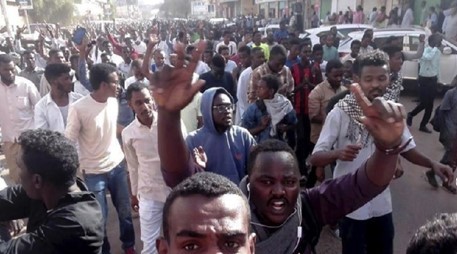7 people killed in clashes with police, say Sudanese activists

- Country:
- Sudan
Sudanese security forces tried again to break up an anti-government sit-in outside the military headquarters in the capital, Khartoum, killing at least seven people on Tuesday, activists behind the demonstrations said. The deaths brought the total number of people killed at the sit-in since the weekend to 15, mainly from among the protesters but also including two soldiers.
The demonstration is the latest in nearly four months of anti-government protests that have plunged Sudan into its worst crisis in years. What initially erupted late last year as rallies against a spiralling economy quickly escalated into calls for an end to President Omar al-Bashir’s 30-year rule. On Monday for the first time, leaders of the protests called on the military’s leadership to abandon al-Bashir and join their call for change. And on Tuesday, they invited military leaders to meet with their representatives to “discuss arrangements for a transition” in Sudan.
Sarah Abdel-Jaleel, spokeswoman for the Sudanese Professionals Association, said the new clashes erupted early on Tuesday between security forces and protesters who have been camping out in front of the military complex in Khartoum for the past four days. The police used tear gas, rubber bullets and live fire to try to disperse the protesters, according to Abdel-Jaleel’s union, which is spearheading the demonstrations. It was the second time security forces failed to break up the sit-in protests, which has grown into one of the biggest rallies in the current wave of unrest.
But a crack seems to be emerging among the Sudanese authorities and the military as to how to handle the protests. Online video footage circulating Tuesday shows some Sudanese troops seeking to protect the protesters and guarding the entrance to the sit-in area. Heavy gunfire can be heard as protesters seek cover from the descending security forces. Other video clips show burned police vehicles used as trash dumps.
The Sudan Doctors Committee, an affiliate of the union, said a military officer, a captain, was killed while defending the protesters Tuesday. The medical group said troops guarding the military’s complex, which also houses the Defense Ministry and a presidential residence, chased the security forces away, firing into the air for the second night. It said that apart from the officer, six protesters were also killed. Abdel-Jaleel, the spokeswoman, said at least 30 protesters were wounded in the violence.
A government spokesman didn’t respond to calls seeking comment. The country's interior minister, Bishara Gomaa, told the parliament on Monday that at least seven people were killed in the protests since Saturday — six in Khartoum and the seventh in the Darfur region. There was no word from the army on the latest military death. A split between Sudan’s militantly and its security agencies could mark a significant turning point for the protesters.
Gen. Awad Mohammed Ibn Auf, the country’s defence minister and also vice president, denied any divisions and said the military and the security apparatus were coordinating on how to deal with the protesters. “There are parties trying to exploit the current situation to create strife between the components of the security system in the country,” he told a meeting with senior officers on Monday.
Despite the deaths, the mood among protesters at the sit-in on Tuesday was upbeat, with online videos showing the demonstrators singing traditional songs and shouting, “Revolution!” They also chanted, “The people want the fall of the regime,” one of the main slogans from the Arab Spring uprisings that swept the Middle East and North Africa in 2011.
With inputs from agencies.
Also Read: Angolan govt to unveil new land management model with Portugal’s help
- READ MORE ON:
- Sudan
- Sudanese activists
- Khartoum
- Omar al-Bashir
ALSO READ
Number of Sudanese forced to flee surpasses 8.5 million after one year of war
US has asked countries in the region to press Iran not to engage in war in Sudan
US has asked countries in the region to press Iran not to engage in war in Sudan
Rape, murder and hunger: The legacy of Sudan’s year of war
Health News Roundup: Peru's dengue deaths triple as climate change swells mosquito population; 'Time running out' in war-torn Sudan as access to aid restricted, WHO warns and more










